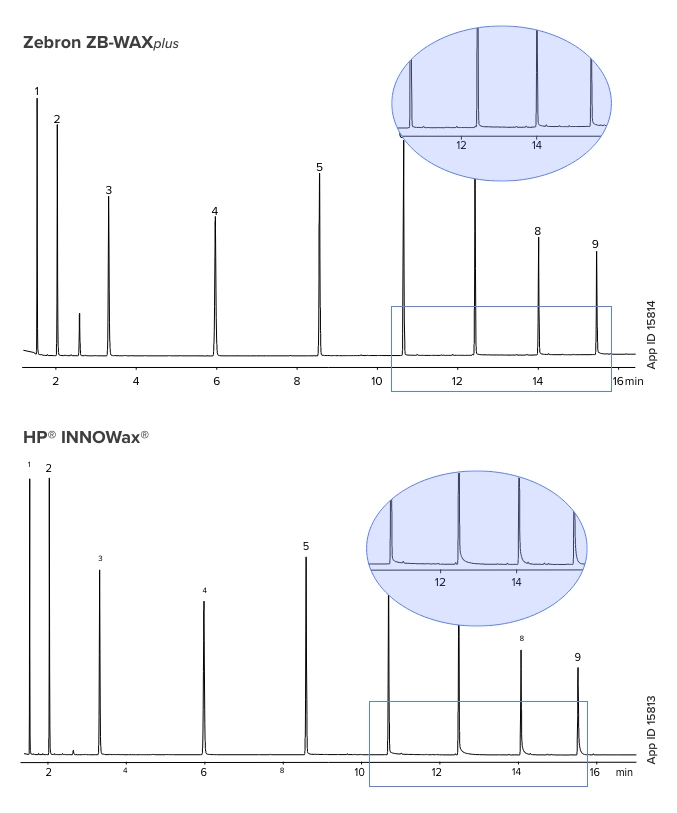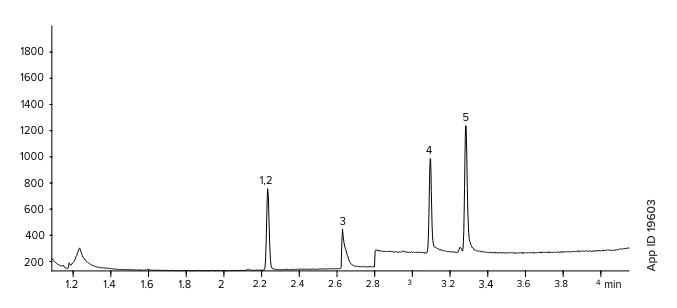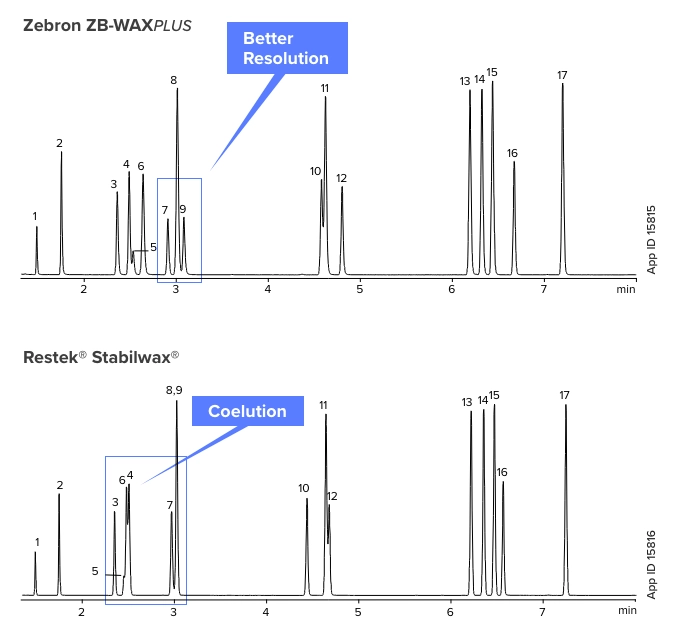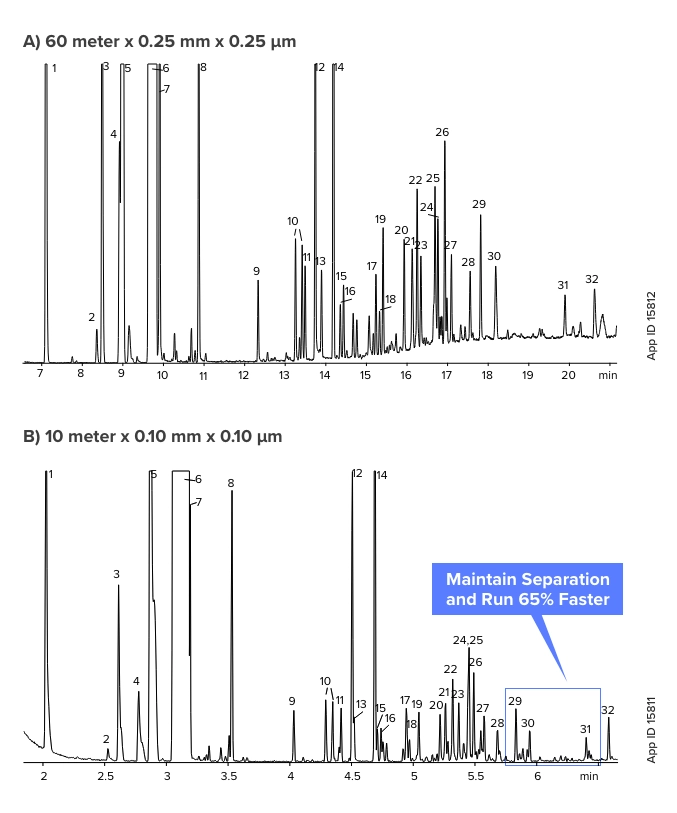Product Information
Phase Detail
Zebron ZB-WAX<span style="font-style:italic; font-variant: small-caps;">plus</span> GC Columns
Zebron ZB-WAXPLUS GC column is 100% aqueous stable and is great for low boiling point solvents and chlorinated solvents
Zebron ZB-WAXplus GC Columns
Zebron ZB-WAXplus GC Columns

100% Aqueous Stability for Polar Compounds
- 100% aqueous stable, excellent for aqueous samples; bonded and solvent rinseable
- Extremely inert for acidic compounds
- Enhanced selectivity for low boiling solvents; high retention of alcohols and chlorinated solvents
- Increased efficiency at 20 °C
Testing free fatty acids? See ZB-FFAP.
Recommended Applications
Alcohols, Aldehydes, Aromatics, Essential Oils, Flavors & Fragrances, Free Fatty Acids, Glycols, OVIs, Pharmaceuticals, Solvents / Residual Solvents, Styrene, Xylene Isomers

Recommended Use Enhanced selectivity for low boiling solvents; high retention of alcohols and chlorinated solvents and extremely inert for acidic compounds |
Upgrade to Zebron from any polyethylene glycol phase:
| Agilent® | Restek® | SGE | Supelco® |
|---|---|---|---|
| DB®-WAX CAM HP-20M Carbowax 20M CP-Wax 52 CB |
Stabilwax® | BP20 | SUPELCOWAX® 10 |
Zebron ZB WAXPLUS GC Column
WAX columns from different manufacturers are not always created equal!
As part of the Zebron PLUS GC column family, ZB-WAXPLUS is manufactured using improved technologies that reflect our attention to detail every aspect of a ZB-WAXPLUS column’s anatomy is meticulously engineered and individually tested for unprecedented performance.

Water Reproducibility of ZB-WAXPLUS
Historically, polyethylene glycol (PEG) phases have been unstable with aqueous samples such as beverages or glycols, resulting in poor reproducibility and decreased lifetime. The ZB-WAXplus bonding procedure results in exceptional stability to repeated injections of aqueous matrices.
Reproducibility and Stability Test

|
Columns:
Zebron ZB-WAXPLUS
|
|
|
Dimension:
30 meter x 0.25 mm x 0.25 µm
|
|
|
Part No.:
7HG-G013-11
|
|
|
Injection:
Split 30:1 @ 140 °C, 0.2 µL
|
|
|
Carrier Gas:
Helium @ 1.4 mL/min (constant flow)
|
|
|
Oven Program:
35 °C for 5 min to 85 °C @ 10 °C/min to
200 °C @ 25 °C/min for 1 min
|
|
|
Detector:
FID @ 200 °C |
|
|
Sample:
1. Acetaldehyde2. Ethyl Acetate 3. Methanol 4. Ethanol 5. Propanol 6. Isobutanol 7. 2-Methylbutanol 8. 3-Methylbutanol |
ZB-WAXPLUS provides optimal selectivity for many aqueous soluble compounds such as those found in alcoholic beverages or glycol samples. The ZB WAXPLUS bonding process results in exceptional stability to repeated injections of aqueous matrices like whiskey. Multiple or routine water injections will not alter the efficiency or polarity of the phase over time.
Distilled Alcohol Standard by Neat Injection on GC-FID

|
Columns:
Zebron ZB-WAXPLUS
|
|
|
Dimension:
30 meter x 0.25 mm x 0.25 µm
|
|
|
Part No.:
7HG-G013-11
|
|
|
Injection:
Split 25:1 @ 210 °C, 1 µL
|
|
|
Carrier Gas:
Hydrogen @ 1 mL/min (constant flow)
|
|
|
Oven Program:
35 °C for 6 min to 60 °C @ 5 °C/min
for 2 min to 210 °C @ 10 °C/min
|
|
|
Detector:
FID @ 230 °C |
|
|
Note:
200 ppm standard in methylene chloride |
Sample:
1. Acetaldehyde 2. Isobutanal 3. Ethyl formate 4. Acrolein 5. Ethyl acetate 6. Acetal 7. Methanol 8. Methylene chloride 9. Ethanol 10. Isobutyl acetate 11. 2-Butanol 12. Ethyl butyrate 13. 1-Propanol 14. Isobutanol 15. Allyl alcohol 16. Isoamyl acetate 17. 1-Butanol 18. 4-Methyl-2-pentanol |
Sample:
19. Methyl-2-butanol 20. Methyl-3-butanol 21. Ethyl caproate 22. Ethyl heptanoate 23. Ethyl lactate 24. Hexanol 25. cis-3-Hexenol 26. Ethyl caprylate 27. Furfural 28. Benzaldehyde 29. Linalool 30. Linalyl acetate 31. Ethyl caprate 32. Diethyl succinate 33. Ethyl laurate 34. 2-Phenyl ethanol |
Don’t Despair – There’s a Solution!
Low column activity is essential to achieving good quantitation and sensitivity. Whether you are analyzing aldehydes, acids, or pharmaceutical compounds the ZB-WAXPLUS provides the highest level of deactivation possible.

Comparative separations may not be representative of all applications.
Conditions same for both columns:
|
Dimension:
30 meter x 0.25 mm x 0.25 μm
|
|
|
Part No.:
7HG-G013-11(ZB-WAXPLUS)
|
|
|
Injection Volume:
Split 100:1 @ 250 °C, 1 μL
|
|
|
Carrier Gas:
Hydrogen @ 1.0 mL/min (constant flow)
|
|
|
Oven Program:
40 °C for 5 min to 200 °C at 10 °C/min
and hold until last peak elutes
|
|
|
Detector:
FID @ 225 °C |
|
|
Sample:
1. Propanal2. Butanal 3. Pentanal 4. Hexanal 5. Heptanal 6. Octanal 7. Nonanal 8. Decanal 9. Undecanal |
Holds Up To Tough Conditions
In addition to inertness, ZB-WAXPLUS columns maintain good performance with difficult matrices and contaminants! The example below shows good results with glycols from seawater, despite the salt and other contaminants commonly found in this matrix.
Glycols From Seawater By GC-MS

Analytical Procedure
Sample Preparation
|
SPE Sorbent:
Strata
|
|
|
Condition:
3 mL Methanol, 3 mL Water
|
|
|
Part No.:
8B-S123-HCH
|
|
|
Load:
1 mL seawater
(basified with ~25 µL of NH4OH) |
|
|
Dry:
Full vacuum 5-10 minutes
|
|
|
Elute:
3 mL or 2 % Formic acid in Methanol |
GC/MS Conditions
|
Column:
Zebron ZB-WAXPLUS
|
|
|
Dimension:
30 meter x 0.25 mm x 0.25 µm
|
|
|
Part No.:
7HG-G013-11
|
|
|
Injection:
Split 10:1 @ 250 °C, 1 µL
|
|
|
Carrier:
Helium @ 1.5 mL/min (constant flow)
|
|
|
Oven Program:
100 °C to 200 °C @ 20 °C/min, post run 5 min @ 250 °C
|
|
|
Detection:
MSD, SIM from 1-2.8 min mass 87 and 89, 2.8-5 min mass 31
|
|
|
|
|
Sample:
Analytes were extracted from seawater (1 mL load @ 5 ppm) 1. D4-2-Butoxyethanol (IS) 2. 2-Butoxyethanol 3. Formic acid (from elution) 4. Propylene glycol 5. Ethylene glycol (IS) |
Improve Resolution

Comparative separations may not be representative of all applications.
Conditions same for both columns:
Dimension:
30 meter x 0.25 mm x 0.25 µm |
|
Part No.:
7HG-G013-11 (ZB-WAXPLUS) |
|
Injection:
Split 100:1 @ 250 °C, 1 μL
|
|
Carrier:
Hydrogen @ 1.0 mL/min (constant flow)
|
|
Oven Program:
35 °C for 2.5 min to 85 °C @ 10 °C/min
and hold until last peak elutes |
|
Detector:
FID @ 225 °C |
|
Sample:
1. Methyl Formate2. Acetone 3. Ethyl Acetate 4. Methyl Ethyl Ketone 5. Methanol 6. 2-Methyl-2-propanol 7. Methylene Chloride 8. Benzene 9. Ethanol 10. 2-Butanol 11. Toluene 12. n-Propanol 13. Ethyl Benzene 14. p-Xylene 15. m-Xylene 16. 1-Butanol 17. o-Xylene |
Faster analysis
ZB-WAXPLUS™ columns provide high efficiency with stable selectivity in a range of dimensions, so you can easily optimize your column dimensions and run up to 65 % faster.

Comparative separations may not be representative of all applications.
Conditions same for both columns:
|
Column:
Zebron ZB-WAXPLUS
|
|
Dimension:
As listed
|
|
Part No.:
A) 7KG-G013-11
B) 7CB-G013-02 |
|
Injection:
A) Split 40:1 @ 220 °C, 0.1 μL
B) Split 20:1 @ 220 °C, 0.2 μL |
|
Carrier:
A) Helium @ 1.2 mL/min (constant flow)
B) Helium @ 0.3 mL/min (constant flow) |
|
Oven Program:
A) 40 °C for 0.2 min to 210 °C @
10 °C/min for 10 minB) 35 °C for 1 min to 250 °C @ 30 °C/min for 5 min |
|
Detection:
MSD; 45-450 amu |
Sample:
1. α-Pinene 2. β-Pinene 3. Sabinene 4. 3-Carene 5. β-Myrcene 6. Limonene 7. β-Phellandrene 8. Octanal 9. Nonanal 10. Limonene Oxides 11. Citronellal 12. Decanal 13. α-Cubebene 14. Linalool 15. β-Cubebene 16. Octanol |
17. Germacrene 18. Caryophyllene 19. trans-p-Mentha-2,8-dienol 20. cis-p-Mentha-2,8-dienol 21. Gerenial 22. α-Terpineol 23. Dodecanal 24. Valencene 25. Citral 26. Carvone 27. Cadinene 28. Perillaldehyde 29. trans-Carveol 30. cis-Carveol 31. Perillol 32. Octanoic acid |












